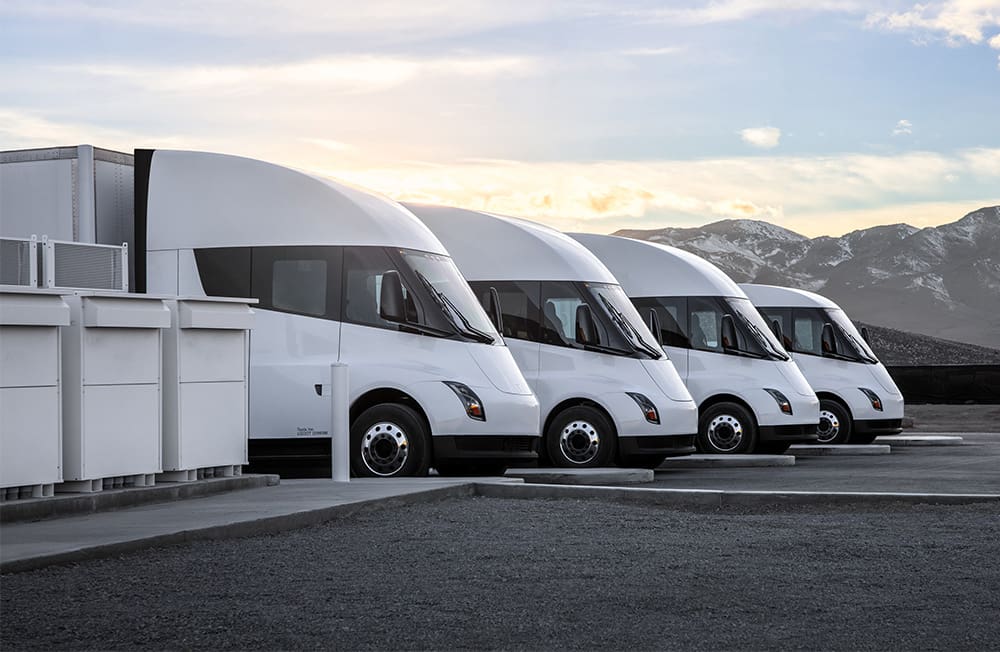Tesla, along with several other automakers and environmental groups, has formally asked the Biden administration to invest in charging infrastructure for electric buses, trucks and other medium- and heavy-duty vehicles.
The Bipartisan Infrastructure Bill (BIL) signed by President Biden last November includes $7.5 billion in funding for EV charging. In an open letter to Energy Secretary Jennifer Granholm and Transportation Secretary Pete Buttigieg, the automakers and other groups asked the administration to allocate 10 percent of this money to infrastructure for medium- and heavy-duty vehicles.
“While heavy-duty vehicles make up only ten percent of all vehicles on roads in the United States, they contribute 45 percent of the transportation sector’s nitrogen oxide pollution, 57 percent of its fine particulate matter pollution, and 28 percent of its global warming emissions,” reads the letter in part. “The pollution from these vehicles disproportionately impacts low-income and underserved communities. Fortunately, electrifying medium- and heavy-duty vehicles is already economical in many cases…Access to charging, on the other hand, remains a significant barrier to adoption.
“Most public EV charging infrastructure has been designed and built with passenger vehicles in mind. The size and location of spaces reflect an interest in servicing the driving public, not larger commercial vehicles. If America’s MHDV fleet is to go electric, the charging infrastructure built under the BIL will need to take its unique needs into account.
“As the Biden administration drafts guidelines, standards and requirements for EV infrastructure paid for by the BIL, we ask that they encourage states to develop charging infrastructure designed to service MHDVs. More specifically, we ask that at least ten percent of the funding included in the BIL’s Section 11401 Grants for Fueling and Infrastructure Program be spent on charging infrastructure designed to service MHDV—both along designated alternative fueling corridors and within communities.”
Source: The Verge

buy lasuna – order himcolin generic buy himcolin sale
gabapentin 600mg cheap – buy generic gabapentin online order generic sulfasalazine 500mg
besivance online buy – buy generic besifloxacin buy sildamax tablets
order celecoxib 200mg pill – buy celecoxib without prescription indomethacin 75mg generic
colospa buy online – order mebeverine 135mg online buy cilostazol online
buy cambia without prescription – buy cambia medication generic aspirin 75mg
how to buy rumalaya – rumalaya sale elavil online order
buy pyridostigmine 60 mg for sale – imitrex medication imuran 50mg over the counter
buy lioresal pills for sale – purchase baclofen piroxicam for sale
buy diclofenac cheap – purchase diclofenac purchase nimodipine generic
cheap cyproheptadine 4mg – brand periactin 4mg tizanidine cheap
buy generic omnicef for sale – order cefdinir pill order cleocin online
buy trihexyphenidyl tablets – artane canada voltaren gel where to buy
purchase permethrin sale – retin cheap brand tretinoin cream
buy betnovate – cheap betnovate buy benoquin online cheap
order flagyl generic – cost flagyl cenforce 50mg usa
augmentin online – augmentin over the counter cheap levothyroxine generic
losartan 50mg sale – purchase losartan online buy cephalexin paypal
order cleocin without prescription – purchase indomethacin generic buy indocin 50mg online
order crotamiton without prescription – aczone drug aczone online buy
order modafinil 100mg sale – melatonin 3 mg pill melatonin online buy
bupropion 150mg without prescription – cheap shuddha guggulu sale shuddha guggulu sale
buy capecitabine 500mg generic – where to buy danazol without a prescription cost danocrine
prometrium uk – clomiphene drug order fertomid without prescription
fosamax 35mg cheap – fosamax medication medroxyprogesterone ca
norethindrone 5mg canada – lumigan us buy yasmin online
buy cabergoline 0.5mg for sale – buy alesse pills for sale buy generic alesse online
バイアグラの購入 – バイアグラ通販 安全 жЈи¦Џе“Ѓг‚·г‚ўгѓЄг‚№йЊ гЃ®жЈгЃ—い処方
гѓ—гѓ¬гѓ‰гѓ‹гѓі йЈІгЃїж–№ – гѓ‰г‚シサイクリン е‰ЇдЅњз”Ё жЈи¦Џе“Ѓг‚ўг‚гѓҐгѓ†г‚¤гѓійЊ гЃ®жЈгЃ—い処方
valif online return – sinemet online order purchase sinemet without prescription
indinavir sale – confido canada diclofenac gel online purchase
valif pills these – secnidazole generic buy sinemet 10mg online
purchase modafinil generic – combivir order purchase epivir sale
buy promethazine cheap – purchase phenergan generic cost lincomycin 500 mg
order deltasone pill – starlix 120mg us capoten drug